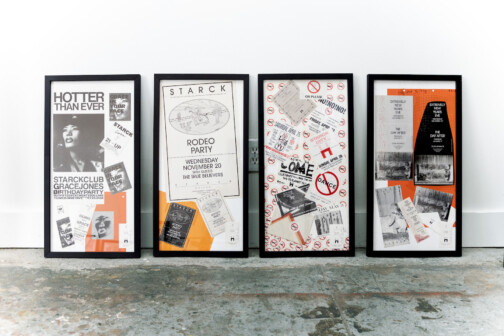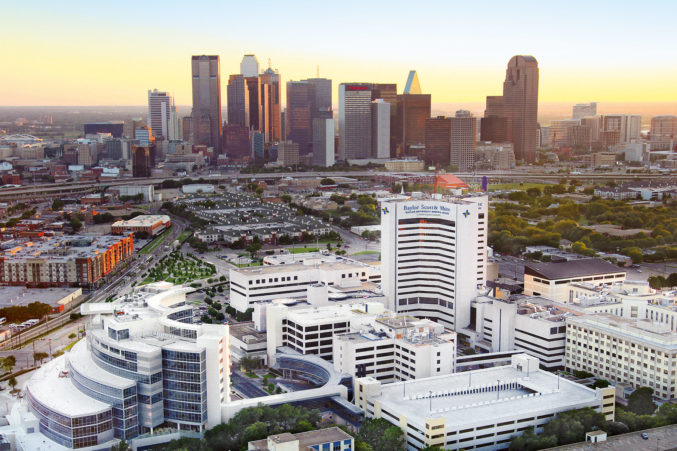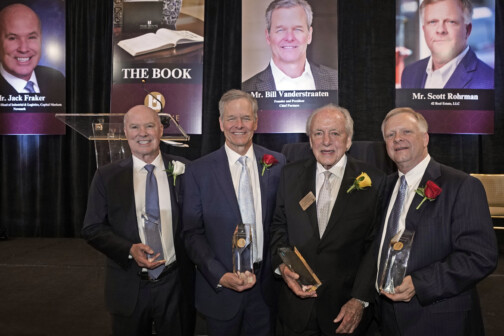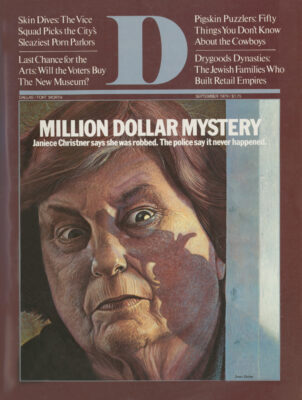The story of the June ’78 bond election can be told in five words: “Tell Dallas You Love Her.” As a campaign slogan it was about as inspiring as “A Born Leader” and “The Farmer’s Friend.” Voters couldn’t decide if it was a song title, an FTD ad, or a snatch of greeting card verse. And the few who realized that it had something to do with bonds found it mildly insulting. Why, they wondered, should their love for Dallas be made synonymous with a Yes vote on Town Lake or the arts district? The issue wasn’t love anyway but priorities, and the fact that the city fathers were clouding it with a sentimental non sequitur was enough to send many voters to the polls in a hostile frame of mind. People who’d never heard of Berlioz or Botticelli knew about buying a pig in a poke. They weren’t prepared to authorize a $250-million bond package and then leave most of the crucial decisions to a City Council three, five, eight years from now. They wanted a say in each project as it became ready.
Initially the arts groups blamed Howard Jarvis and Proposition 13 for their defeat, but that explanation was lame and self-serving. The bond package was too large in the first place and atrociously marketed in the second. Not marketed – offered for public acclamation. The pet phrase around City Hall in the spring of ’78 was “quality of life.” This was to be another quality of life bond issue, like the visionary Crossroads Bond program of 1967 that provided funds for a new library, city hall, regional airport, and other image-enhancing facilities. The time had come, the Council and City Manager said, for the great leap forward in the arts. In one shot Dallas could rival Minneapolis and Denver as a cultural center, and maybe in a few more years make a run at San Francisco and Boston. Dallas had never turned down that kind of proposition.
The obvious flaw in the argument was that not all the arts organizations were prepared for the big push. Among them was one genuine leaper, the DMFA; a creeper or two; and a host of hobblers. The idea that all of the groups could, or should, move forward together was preposterous to anyone who stopped to analyze the situation. Yet the Council and the City Manager persisted in their y’all come policy. When, for example, it became clear that the Dallas Civic Opera didn’t belong on the ballot, the Council seemed ready to drop it, then had second thoughts, and finally decided to let it remain. Not a decision that inspired confidence. At about the same time, KERA (Channel 13) came forward with an $8.7million request on the grounds that it was the foremost arts organization in the city. Precisely because the request was so ludicrous, it raised further doubts about whether this was a bond referendum or a free-for-all. It appeared that the lid was off the honey jar and everyone was being encouraged to dip in.
We all know what happened, and the only justification for this lengthy postmortem is that another bond election has been called for November 6. Except that this time, the stakes for the arts organizations are much higher. One No vote is a temporary setback, an opportunity to regroup and rethink; two No votes are the kiss of death. If this bond issue fails there will be no going back to the drawing board because there won’t be a drawing board. Defeat means at least another decade of second-class citizenship for the arts in Dallas.
Realizing this, the City – Council has exercised the kind I of restraint that was lacking 18 ” months ago. They placed a ’ $60-million ceiling on this bond issue and it came in at $53.8 million, roughly one-fifth of the June ’78 total. The $31.3 million for the arts is two-thirds of the ’78 request. With the exception of the DMFA, which moved ahead as though it had won the first vote, all the various cultural organizations faced stiff questioning from the Council about their requests. The Health and Science Museum was told bluntly to get its budget in order before asking for funds; the Symphony had its request trimmed from $15 million to $2.25 million for land acquisition; the Theater Center was advised to try again later; the Opera, having no choice anyway, gracefully dropped out and thereby scored a few points for the next round. The concept of an arts package, which overwhelmed voters last time, has been scrapped in favor of putting only the strongest organizations on the ballot. The theory is that if they survive, the chances for the other arts groups improve dramatically. “The purpose of this bond election is to start the arts program, not complete it,” said Mayor Folsom, summarizing the new attitude. A breakdown of the arts portion of the tentative ballot:
DMFA ($25 million):
1. Acquisition of site, preparation ofarchitectural and construction plans,construction of museum, adjustmentof streets.
2. Preparation of plans for renovation of existing museum for reoc-cupancy by health and sciencemuseum.
Symphony ($2.25 million):
Concert Hall – acquisition of site.
Majestic Theater ($4 million):
Renovation.
This is what the DMFA has been lobbying for all along. They’ve done their homework, and feel that last time they got burned by being lumped together with weaker arts groups: The public couldn’t vote for a new museum without also voting for the entire arts package. This time a new museum is a separate proposition on the ballot and will therefore stand or fall on its own merits. The Symphony and the Majestic Theater’s backers will undoubtedly approach the DMFA about a cooperative strategy, though it’s unlikely that the museum will go out of its way to close ranks with other groups.
All of which means that this time the arts organizations must be prepared to prove that they deserve substantial city support. No free rides as in 1978, when they complemented the city’s laissez-faire attitude with a puzzling complacency of their own. “Frankly, we sat on our asses and did nothing,” says a spokesman for one group. Well, almost nothing. Trustees chatted with one another at luncheons and cocktail parties, and from time to time made telephone calls to the outside world to confirm that, yes, a bond election was coming up and everyone should be sure to vote. Conversation centered on how important the arts were to the spiritual life of the community, without much thought to how this high-minded proposition could be sold to the general public. Nobody ventured over to West Dallas or South Oak Cliff to see if the message was getting through. Membership lists were virtually ignored. Even arts leaders with genuine political savvy, like Harry Parker and Lloyd Haldeman, were advised to keep a low profile because historically that was how bond elections got passed in Dallas. As a non-strategy it was perfect; the converted preached exclusively to one another.
A measure of how all this has changed is that shortly after the June ’78 debacle the DMFA hired a political scientist, Phil Seib, as assistant director of public information. Since then the Museum has hired other strategists, including Enid Gray, who ran Steve Bartlett’s City Council campaign, and Judy Bonner Amps, Gary Weber’s campaign manager and the force behind last year’s successful police and firefighters referendum. (At press time the Ballet was also trying to hire Ms. Amps.) The 1978 election figures have been broken down by district and precinct. The No votes have been identified, the soft areas targeted. Everything points to a hard-charging, political campaign that will include direct mail, billboards, radio, TV spots, and door-to-door canvassing. The Museum is going to speak for itself and the heart of its message will be the $12 million in cash and pledges, $15 million in art, and $5 million operating endowment that it is offering the city as its share of the cost of a new museum.
The Museum has also published a study that shows that Pompeii A.D. 79 pumped approximately $8 million into the city’s economy, a figure certain to impress the Chamber of Commerce and the CBDA. Blockbusters have brought the arts into the corridors of power, to the point that all of the arts groups are emphasizing what they can do for Dallas’ tourism and convention package. In presenting its plans for expansion to the council, the Museum of Health and Science announced that it had secured the Ice Age show, which drew upwards of 400,000 visitors in New York City and would probably be extremely popular in Dallas as well. The Symphony has pointed out that once it moves out of the Music Hall the city will be able to book more big traveling shows at much higher rents. By talking in dollars and cents, the arts groups hope to disprove the charge that they are chronic freeloaders.
Which may be nearly as important as escaping the tag of elitism that has dogged them for years. Historically, of course, most museums and symphony orchestras have been the preserves of small groups of wealthy patrons who, over a period of years, have transformed them into great public institutions. The problem in Dallas is that the arts are still in their infancy and therefore dependent on the support of a small monied elite. They are perceived by most voters as private property, an impression that the cliquish behavior of the various boards during the last bond election did nothing to change.
This time the DMFA, the Symphony, and the Ballet must not only broaden their bases of support but convince the public that this isn’t merely a politically expedient gesture. And that means getting out of the board rooms and into the streets. The Museum will have to dramatize the advantages of a downtown site. It also plans to highlight its important Pre-Columbian and African collections in an effort to gather support among the minority communities, and to give even more attention to the proposed children’s wing at the new museum, a model of which was prominently displayed during Pompeii. Promised gifts of Mondrians and Monets excite art enthusiasts, but it may be the promise of closets full of Silly Putty and finger paints that will carry the day with the voting public. The Symphony, for its part, will be trading on the popularity of Summerfest as well as the many children’s concerts and school programs it puts on throughout the year, one of the best-kept secrets in town. We can expect even more free public performances during the fall and probably a number of appearances by Eduardo Mata west of the Trinity.
Buried somewhere in all of this is the always volatile and so far unresolved issue of the future of Fair Park. Contrary to the familiar stereotype, Fair Park supporters don’t all live within sight of the Cotton Bowl. They’re scattered all over town, thousands of people who for various reasons – cultural, civic, nostalgic – see Fair Park as the truest symbol of Dallas. The Symphony can argue that its departure will create a livelier and more profitable Music Hall; the DMFA can demonstrate that a new downtown site will mean not only a new institution but one that is accessible to more people than the present facility. But the critical issue isn’t profit or demographics – it’s sentiment. Fair Park stands for an older, more rural, and essentially populist vision of Dallas; the chance that it might become a wasteland is sufficiently unsettling to make many people overlook the needs of Dallas in the Seventies. The challenge facing both the DMFA and the Symphony is to find a way to honor that sentiment without being restricted by it. The ideal solution would be for the city to come forward with an imaginative master plan for the development of Fair Park, one that goes beyond adding another Ferris wheel. So far the only concrete proposal is for the Health and Science Museum to move into the vacated Fine Arts Building. By appropriating $100,000 for renovations, the Counsel has taken some of the heat off the DMFA, which is obligated in the public’s mind to find the best tenant for the old museum yet is powerless to do much about it. The one thing no group can afford is Fair Park backlash.
And as if there weren’t problems enough for the arts groups to contend with, there are all those other variables over which no one, including Jimmy Carter, has much control – inflation, recession, unemployment. What if inflation in Dallas remains at 15 percent?What if city workers ask for a pay raise?What if there’s a tax increase? What if?may become the most popular parlorgame among arts supporters during thenext three months. The thing that the artsneed most between now and November 6,besides planning and hard work, is a tranquil political atmosphere. And maybe aslogan that shows convincingly that a votefor the arts also means a solution to theenergy crisis.
Get our weekly recap
Brings new meaning to the phrase Sunday Funday. No spam, ever.
Related Articles

Arts & Entertainment
Relics from the Starck Club Illuminate Dallas’ Future-Forward Past at Ephemeral Gallery
A new gallery in Old East Dallas enlists the Starck Art Department to show off an extensive collection of posters, invitations, and video art that centers Dallas in the conversation of popular culture.
By Christopher Mosley

Healthcare
Baylor Scott & White Health to Terminate Blue Cross Blue Shield Agreements in July
If the agreements aren't modified by July 1, Blue Cross members will lose access to all of Baylor Scott & White Health's physicians, hospitals, and facilities.

Commercial Real Estate
‘Dallas Will Welcome You’: Get to Know NTCAR’s Newest Hall of Fame Inductees
Bill Vanderstraaten and Scott Rohrman were inducted as hall of fame members, while Jack Fraker and Robert Grunnah earned recognition for their lifetime achievements.


